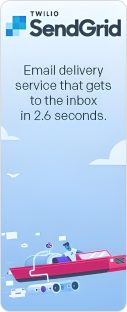The global banner advertising industry is growing exponentially. The industry was valued at 64 billion U.S. dollars in 2021 and is expected to be worth $87.14 billion by 2028.
Results for “”

The global banner advertising industry is growing exponentially. The industry was valued at 64 billion U.S. dollars in 2021 and is expected to be worth $87.14 billion by 2028.
Banner ads offer precise targeting capabilities allowing businesses to reach specific audiences based on demographics, interests, browsing behavior, and other segmentation criteria.
Banner ads provide measurable results and analytics, which can inform future marketing and sales campaigns. It is also a performance-driven marketing tactic, which helps demonstrate and quantify ROI.
Banner ads enhance brand visibility and recognition, driving increased brand awareness among your target buyers. Effective banner ads have also been found to increase recall during the buyer’s journey.
Banner ads are typically displayed in a variety of dimensions as images on websites. They promote products, services, or brands and help to boost user engagement and conversions.
In order for banner ads to be effective, they need to be created with eye-catching visuals and compelling copy, to drive performance on the channels they are deployed on (such as websites or social media channels). They are strategically used for generating demand, brand awareness, or driving website traffic, and as such, serve as an effective tool in demand generation strategies.

Banner ads can increase brand awareness by 80% by showcasing the brand in mediums and across marketing channels that match with the preferences of your buyers in a strategic and visually-appealing manner.
In fact, display/banner ads can generate an average click-through rate (CTR) of 0.35% (HubSpot, 2020), which also supports brand awareness by driving traffic toward your website and content marketing assets—and contributing to delivering a specific buyer’s journey to target audiences.
Example banner ad
This banner ad by SendGrid adopts a straightforward approach, effectively addressing a common demand (or pain point) of most email marketers (ensuring emails are received by their target audience).
One of the key strengths of this banner ad lies in the use of the 2.6 seconds stat, which acts as a concise and powerful hook to reel in the attention of the ad’s target audience.

Source: Linear Design
Banner ads complement other initiatives like paid media and SEO to drive traffic to your website, including specific content or pages. The benefit of using banner ads over other strategies is the high number of clicks you can derive quickly from a relatively low cost campaign.
Example banner ad

Source: AdEspresso
This ad from Nanopay on the Forbes website showcases the core benefit of the brand’s liquidity management services.
The concise copy leverages a key messaging point that draws in the attention of a specific audience, which requires an equally specific solution to achieve their goals (managing liquidity for corporate clients).
While simplistic, its brevity is beneficial and encourages an open loop of curiosity that motivates potential buyers to click to learn more, particularly if they are actively searching for a solution.
At the very least, the ad will support brand recall and organic searches when the buyer is ready to research their options (which demonstrates how paid media benefits SEO).
Banner ads can also be harnessed to drive interest in a new product as part of a dynamic and high-performance strategy. With the right combination of design and copy, banner ads can create anticipation and generate buzz around product launches, supporting enhanced engagement and sales opportunities.
Banner ads can generate curiosity and demand for a new product, especially when targeting buyers that meet ideal client profile criteria (ICP) for each product. Promotion can also start before a product launch to boost sales by sparking interest and supporting recall before it even gets to market.
The guiding principle for banner ads to successfully drive product launches or promotion, is to emphasize the Unique Value Proposition and Selling Points (UVP and USP) of the new product, helping to keep it top of mind among buyers. This tactic is most effective when these targeted buyers are followed up later with another banner ad strategy or form of content marketing.
Banner ads excel at targeting customers with specific pain points. Data-driven insights can be leveraged to identify audience segments with individual needs for precision targeting. Through tailored messaging, banner ads can successfully address pain points and present relevant products or services to boost conversions. This targeted approach increases the chances of capturing the attention of prospective clients.
Paid media networks and tools (especially through social channels), allow for precise audience targeting, ensuring that banners are delivered to the ideal buyers for specific campaigns.
This means the banner ad can be custom-tailored, and if utilizing an Account Based Marketing approach, personalized on a one-to-many basis.
Example banner ad
Microsoft tailored banner ads to resonate with the specific pain points of coders, programmers, and app builders, positioning how their Azure solution can tackle them. The variation of copy per banner demonstrates how Microsoft’s strategy leveraged personalization and catered to evolving buyer needs.

Source: Acquisio
Banner ads are a great way to reconnect with users who have previously interacted with your brand website. By implementing tracking pixels, businesses can identify these users and display relevant ads across various websites and social channels according to the preferences of prospects.
Retargeting site visitors with banner ads makes them 70% more likely to convert, which demonstrates the importance of engaging buyers with additional touchpoints and the role of banner ads in facilitating this.
Create visually appealing banner ads: Captivate interest with persuasive, concise copy and simple imagery that reinforces your brand values.
Craft compelling Calls-to-Action (CTA)s: Stand out with precise CTAs that encourage users to click. Establishing open loops in the copy, which require a click for a sense of closure, is a solid tactic for banner ads.
Ensure the banner ads are responsive: Make sure to take advantage of responsive templates to engage buyers on mobile, an increasingly popular medium (and where many buyers access their social channels).
Conduct A/B testing: Create variations of banner ads to test different elements, such as visuals, copy, and CTAs. This will help identify the most effective combination for driving demand.
Choose channels that are relevant to your target audience: Maximize the exposure and impact of your banner ads by selecting websites and social channels your Ideal Client Profile (ICP) audience frequents the most.
Implement tracking methods: Utilize analytics tools to gather data on ad impressions, clicks, conversions, and more. This will empower you to measure the success and ROI of your banner ad campaigns.
Get in touch with 1000+ demand generation experts experienced with paid media and banner ad initiatives with clients worldwide. The INFUSE team is available 24/5 to discuss your goals and plan a campaign that will exceed your intended outcomes.
GET IN TOUCH WITH A DEMAND EXPERT AT letstalk@infuse.com

Nevilson Christian is the Founder of SeekThem, a creative design and branding agency. With a passion for design, Nevilson has established the company as a leader in branding solutions. Over the years, the company has helped numerous clients develop a strong and consistent brand identity, and Nevilson continues to lead the team in delivering exceptional results.
To provide the best experiences, we use technologies like cookies to store and/or access device information. Consenting to these technologies will allow us to process data such as browsing behavior or unique IDs on this site. Not consenting or withdrawing consent, may adversely affect certain features and functions.
